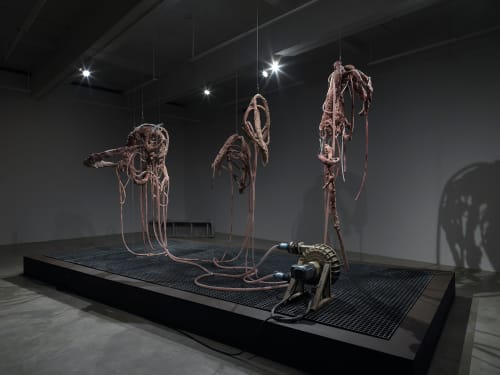The first time you encounter Mire Lee’s artwork your mind might race toward an unsettling observation that eludes your memory, perhaps from William Burroughs’s Cities of the Red Night (1981), Robert Smithson’s essay, “Entropy and the New Monuments” (Artforum, 1966), or Donna Haraway’s Simians, Cyborgs, and Women: The Reinvention of Nature (1991), or a scene from the film Alien (1979) or a “B” horror movie. These are just some of the associations the work elicited when I visited the artist’s debut exhibition, Mire Lee: Carriers at Tina Kim Gallery (September 15–October 22, 2022). But, more importantly, the work soon took over, obliterating these connections, and I found myself sitting and staring, not knowing exactly what I was looking at. That inability to quite contain the work within a pre-existing category or definition is very much part of its challenge and meaning.
The first gallery contains hollow concrete objects that resemble elongated pods with an opening or a cluster of spine or hollow rib-like forms, a short video of a woman, first outside with her bicycle and later puttering in the kitchen, and three distressed nettings hanging from metal rods. None of these prepared me for what was in the second gallery, even though I knew there would be a machine, dripping liquids, and entrail-like forms from seeing reproductions and short clips of Lee’s kinetic work. I suspected that the woman in the video — who happens to be the artist’s mother — is central to the entire exhibition, but in no obvious way. The open forms, or concrete shells, and the nettings fall under the definition of “carrier,” as a means of carrying something, but that still does not explain the feelings that surfaced as I engaged with the installation in the second gallery.
After walking through a dark corridor, between two walls, one of which was made from weathered plywood panels, I turned a corner and entered a large, dark, windowless room, its stained, plywood-paneled walls smelling of machine oil. A large, hollow, dark brown metal platform, set at a diagonal and covered with black metal grating, takes up most of the space. Three moving, dripping, slime-covered, knotted, tentacular forms hang above the platform, suspended by wires from the ceiling. Smooth transparent tubes connected to a pump in one corner of the platform dangle from them. The pump pushes a clear, oily liquid and air pockets into the rubbery, twitching tentacles, which bleed out of them, dripping into the box. The continuous cycle is punctuated by a sound that recalls something between a machine and a slowed-down heartbeat. I sat on the concrete bench in one corner. No one else who came into the space joined me.
Sitting in a dark room with spotlights focused on the suspended forms, I found the experience strangely comforting, and the noise oddly soothing. Few people stayed very long, and who can blame them? Whatever else Carriers is about, it seems to me that has to do with sending you back into yourself, which is not necessarily a soothing place. This is why all of the science fiction and horror allusions began to dissipate, leaving just me and this machine. To use fiction of any sort to place this work in an alternative world blunts the visceral impact of the noise and movement of the disturbing tentacular forms, their herky-jerky repetitive motion in the windowless space, with wood panels that exude a distinct smell of machinery — a dirty, sacred space.
We might ask, what does this room signify about the world of which it is a part? To what part of our body or psyche is it meant to speak and touch? Is the fact that it evokes the body but its gender is indeterminate part of the work’s meaning? The swirl of questions kept me in the room, looking and reflecting. I repeatedly went back to the word “carriers” and all the things it brought to mind, some of which had to do with the pandemic and awareness of contagions. But Carriers does not seem topical in that regard. Rather, the constantly flowing fluids endow the intestinal-like forms with a squeamish sensuality, at whose origin the press release hints:
"A telling reference for Lee is vore, a fetish involving the impossible urge to swallow the object of one’s desire in a total annihilation of boundary between self and other, necessitating a supreme violence. Rather than offer a clear aggressor or desiring party, Carriers, both the work and as an exhibition, instead turns to uncompromising partiality, reminiscent of the familiar or bodily in its spurting cavities without committing to a single, identifiable form."
Vorarephilia is the erotic desire or sexual fantasy to be consumed or to consume another. In the video, “Mom in Amsterdam” (2022), which is projected onto the concrete surface of an upright slab, the mother is cooking, presumably for her artist daughter, a benign activity that takes on sinister overtones in relation to the “vore” theme, but from whom do these overtones issue? The netting and the concrete objects, with an opening and cavity, can be read as wombs or “carriers.” If, as the press release states, there is no “clear aggressor or desiring party,” then what the installation, Carrier, conveys is a disturbing impasse, a swallowing of the desire so that it does not crush either the desire or the desired.
This was my first direct encounter with Lee’s work. I felt that trauma was a likely inspiration and in that regard it shared something with the work of Hans Bellmer, Louise Bourgeois, and Lee Bul, while the aesthetic is unique to this artist. Lee is more than capable of making viewers’ skin tingle, and unnerving them in ways that speaks to the darkness inhabiting our unconscious. That is not an enviable place to be, but it is a powerful one.
Mire Lee: Carriers continues at Tina Kim Gallery (525 West 21st Street, Chelsea, Manhattan) through October 22. The exhibition was organized by the gallery.
—John Yau


